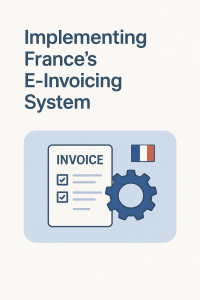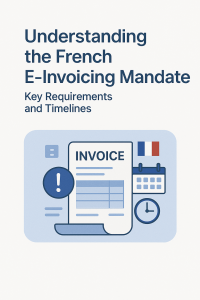Introduction: From Awareness to Action
In the first two articles of this series, we covered:
- Article 1: Why France is introducing e-invoicing and how the system works.
- Article 2: The scope of obligations, from B2B and B2C to cross-border transactions.
Now it’s time to get practical.
With deadlines approaching in September 2026 and September 2027, businesses need a readiness roadmap. For foreign entrepreneurs, this means understanding your French VAT footprint, choosing the right technology path, and ensuring your systems and teams are aligned.
This article provides a 90-day plan to prepare your company for France’s e-invoicing and e-reporting mandates.
Why Start Now?
Even though the mandate starts in 2026, preparation is not optional. Here’s why:
- ERP upgrades take time. Adapting accounting systems to generate Factur-X, UBL, or CII is not a quick fix.
- PDP onboarding slots are limited. Certified platforms will have high demand—latecomers risk delays.
- Compliance is not just IT. Finance, tax, legal, and operations teams all need to adapt.
- Clients expect readiness. Large companies may pressure their smaller partners to comply early to avoid disruption.
👉 Starting early means turning compliance into a competitive advantage.
Step 1: Verify Your French VAT Footprint
Before you can plan, you must define your legal position in France:
- Do you have a French subsidiary (legal entity with a SIREN)?
- Full e-invoicing + e-reporting obligations apply.
- Are you non-resident but VAT-registered in France (without establishment)?
- Must be able to receive e-invoices and comply with e-reporting obligations.
- Are you not VAT-registered in France?
- No obligations—for now. But monitor if your activities trigger VAT registration.
👉 Action: Confirm your SIREN number and VAT ID. Verify that they are correctly listed in the central e-invoicing directory managed by DGFiP.
Step 2: Map Your Invoice Flows
Create a simple map of how your business invoices today:
- Domestic B2B (France → France) → Subject to e-invoicing
- B2C (France → Consumers) → Subject to e-reporting
- Cross-border B2B (France → EU/Non-EU) → Subject to e-reporting
- Cross-border B2B (Inbound to France) → May require reporting depending on VAT mechanism
- B2G (France → Government) → Already mandatory via Chorus Pro
👉 Action: Document all your transaction types and assign them to the correct compliance category.
Step 3: Choose Your Connection Strategy
Businesses can comply via two main routes:
- Partner Dematerialisation Platform (PDP)
- Registered with DGFiP
- Can exchange invoices with other PDPs and transmit mandatory data to the State
- Often offers value-added services (archiving, analytics, ERP integration)
- Public Invoicing Portal (PPF)
- Free, provided by DGFiP
- Covers basic functions: directory look-up, data transmission
- Less flexible and limited in terms of integration/customization
👉 For most foreign entrepreneurs with significant activity, a PDP is the recommended choice. SMEs or startups with low volumes might rely on the PPF.
Step 4: Adapt Your ERP or Accounting Software
Your system must be able to:
- Generate invoices in UBL, CII, or Factur-X format
- Include the new mandatory data fields (SIREN, operation type, delivery address, VAT on debits)
- Handle invoice lifecycle statuses (issued, received, accepted, rejected, paid)
- Connect to your chosen PDP or PPF
👉 Action: Contact your ERP/accounting software provider now to confirm their readiness. Most global vendors (SAP, Oracle, Xero, QuickBooks, Sage) are updating modules for France.
Step 5: Implement E-Reporting
E-reporting is often overlooked but equally important.
Your system must send transaction summaries for:
- B2C sales
- Cross-border B2B transactions
E-reporting must include:
- Transaction date
- Customer country (if applicable)
- VAT rate and amount
- Gross/net amounts
- Payment details for services
👉 Action: Align your POS, e-commerce, and ERP systems to ensure B2C and cross-border sales are properly tracked and reported.
Step 6: Test Your Invoice Lifecycle
E-invoicing is not just about sending data—it’s about managing the entire lifecycle:
- Invoice issued → delivered → acknowledged → accepted/rejected → paid
- Each step generates status updates that flow back to your system
- These statuses must be processed correctly in your ERP for reconciliation and reporting
👉 Action: Run pilot tests with a supplier and a client using a PDP. Validate that lifecycle statuses appear correctly in your system.
Step 7: Train Your Finance Team
Technology will not replace the need for human understanding.
Your finance team must learn:
- How to issue, receive, and validate e-invoices
- How to handle rejections or status mismatches
- How to reconcile e-reporting data with VAT returns
- How to maintain archiving and audit trails
👉 Action: Schedule training sessions (in English if needed) with your PDP or accounting provider.
Step 8: Plan for Archiving and Audit
France requires 10-year invoice archiving. Your solution must guarantee:
- Integrity (data cannot be altered)
- Accessibility (readable format for audits)
- Traceability (audit trail of changes and statuses)
👉 Action: Confirm whether your PDP provides certified e-archiving or whether you need a separate archiving provider.
A 90-Day Readiness Plan
Here’s a practical breakdown:
Days 0–30: Readiness & Scoping
- Confirm VAT status (subsidiary vs non-resident)
- Verify SIREN/VAT in central directory
- Map transaction flows
- Shortlist PDPs
Days 31–60: Build & Integrate
- Adapt ERP to generate structured invoices
- Add new mandatory fields
- Configure e-reporting flows
- Test with PDP sandbox
Days 61–90: Test & Govern
- Run pilot invoices with partners
- Validate lifecycle statuses
- Train finance team
- Finalize archiving strategy
- Draft compliance policy
Practical Checklist
- VAT footprint confirmed (subsidiary vs non-resident)
- SIREN and VAT ID validated in central directory
- PDP/PPF connection route chosen
- ERP updated to generate Factur-X/UBL/CII
- New mandatory fields integrated
- E-reporting configured for B2C/cross-border
- Lifecycle statuses tested
- Finance team trained
- Archiving solution in place
Common Mistakes to Avoid
- Waiting until 2026. ERP and PDP capacity will be bottlenecks.
- Focusing only on e-invoicing. Forgetting e-reporting creates compliance gaps.
- Ignoring master data. Wrong SIREN or VAT ID means invoices get rejected.
- Assuming PDFs are compliant. Only structured formats are valid.
- Forgetting archiving. Non-compliant storage exposes you to fines and audit risks.
Conclusion: Be Ready Before the Deadline
France’s e-invoicing mandate is a structural change, not a simple IT tweak. For foreign entrepreneurs, the challenge is even greater because it requires adapting cross-border business models to French-specific rules.
By following this 90-day roadmap, you can ensure your company is not only compliant but also efficient and competitive when the reform goes live.
👉 In Article 4 of this series, we will take the final step: how to implement e-invoicing in practice, from choosing a PDP to testing your first live transactions.




